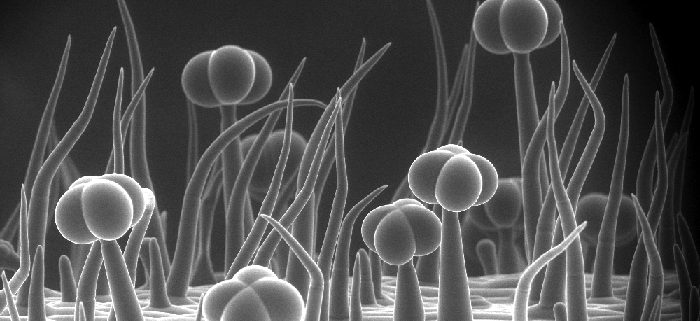Tomato Hairs and Metabolites – A Dual Narrative
Xu et al. find that the transcription factor SlMYC1 is involved in trichome formation and regulates mono- and sesquiterpene biosynthesis differentially in leaf and stem trichomes in tomato.
By Robert Schuurink, Department of Plant Physiology, University of Amsterdam, NL
Background: Many plants have hairs (trichomes) on their leaves and stems to defend themselves against insects, as trichomes form physical barriers. Some of these hairs have glandular cells on top that produce special metabolites that can be toxic to insects or, when gaseous (volatile), can attract enemies of these herbivores. The production of volatile metabolites is often induced by herbivores. Tomato has eight types of hairs, but we know relatively little about their development and the regulation of their special metabolite production. Cultivated tomato has glandular trichomes (type VI) that produce volatile terpenes. These molecules are produced by many plants as defense compounds and are often utilized in food and cosmetics as flavors and fragrances.
Question: We wanted to know if, in cultivated tomato, the previously identified regulatory protein MYC1 is involved in the development of type VI glandular trichomes or the regulation of volatile terpene production. We tested this by switching the MYC1 gene off and by expressing a more stable MYC1 protein.
Findings: We found that cultivated tomato plants can only develop these glandular trichomes when they produce MYC1. When MYC1 was switched off, type VI glandular trichomes did not develop, although other trichome types did. When MYC1 production was turned down, smaller type VI trichomes developed that produced fewer volatile terpenes. Interestingly, on stems, these smaller trichomes suddenly produced additional volatile terpenes, indicating that MYC1 normally represses their production. Expressing a stable MYC1 specifically in the glandular cells of these trichomes supported these data. Thus, surprisingly, the protein MYC1 has a dual regulatory function in both metabolism and development.
Next steps: Scientists aim to tweak crop plants to produce more special metabolites against herbivores, like their wild relatives quite often do. We would like to find out if MYC1 plays a similar role in the wild relatives of tomato and whether increasing the expression of MYC1 leads to the formation of more type VI glandular trichomes and/or volatile terpenes.
Jiesen Xu, Zeger O. van Herwijnen, Dörthe B. Dräger, Chun Sui, Michel A. Haring, Robert C. Schuurink. (2018). The transcription factor SlMYC1 regulates mono- and sesquiterpene biosynthesis differentially in leaf and stem trichomes and is involved in the formation of type VI glandular trichomes in tomato. Plant Cell 30: 2988-3005; DOI: https://doi.org/10.1105/tpc.18.00571




